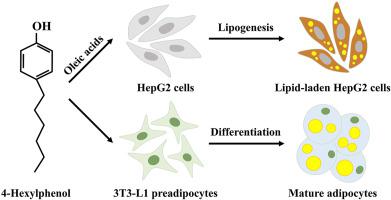Environmental Pollution ( IF 7.6 ) Pub Date : 2020-10-04 , DOI: 10.1016/j.envpol.2020.115635 Zhendong Sun , Huiming Cao , Qian S. Liu , Yong Liang , Heidelore Fiedler , Jianqing Zhang , Qunfang Zhou , Guibin Jiang

|
Finding the potential environmental obesogens is crucial to explain the prevalence of obesity and the related pathologies. Increasing evidence has showed that many chemicals with endocrine disrupting effects can disturb lipid metabolism. Whether 4-hexylphenol (4-HP), a widely-used surfactant and a potential endocrine disrupting chemical (EDC), is associated to influence adipogenesis and hepatic lipid accumulation remained to be elucidated. In this study, both the 3T3-L1 differentiation model and oleic acid (OA)-treated HepG2 cells were used to investigate the effects of 4-HP on lipid metabolism, and the underlying estrogen receptor (ER)-involved mechanism was explored using MVLN assay, molecular docking simulation and the antagonist test. The results based on lipid droplet staining and triglyceride accumulation assay showed that 4-HP treatment promoted the adipogenic differentiation of 3T3-L1 cells and increased hepatic cellular OA accumulation in exposure concentration-dependent manners. The study on the elaborated transcription networks indicated that 4-HP activated peroxisome proliferator-activated receptor γ (PPARγ) as well as the subsequent adipogenic gene program in 3T3-L1 cells. This chemical also induced the increase of OA uptake and decreases of de novo lipogenesis and fatty acid oxidation in HepG2 cells. The agonistic activity of 4-HP in triggering ER-mediated pathway was shown to correlate with its perturbation in lipid metabolism, as evidenced by the enhanced development of mature lipid-laden adipocytes and suppression of excessive hepatic lipid accumulation upon its co-treatment with ER antagonist. Altogether, these findings provide new insights into the potential health impacts of 4-HP exposure as it may relate to obesity and nonalcoholic fatty liver disease.
中文翻译:

4-己酚影响体外成脂分化和肝脂质蓄积
寻找潜在的环境致病原对于解释肥胖症的流行及其相关病理至关重要。越来越多的证据表明,许多具有内分泌干扰作用的化学物质会干扰脂质代谢。4-己基苯酚(4-HP)是一种广泛使用的表面活性剂和潜在的内分泌干扰化学物质(EDC)是否与脂肪形成有关,肝脂质蓄积尚待阐明。在这项研究中,使用3T3-L1分化模型和油酸(OA)处理的HepG2细胞来研究4-HP对脂质代谢的影响,并使用MVLN探索了潜在的雌激素受体(ER)参与机制。分析,分子对接模拟和拮抗剂测试。基于脂质滴染色和甘油三酸酯积累测定的结果表明,4-HP处理以暴露浓度依赖性方式促进3T3-L1细胞的成脂分化并增加肝细胞OA的积累。对精细转录网络的研究表明,4-HP激活的过氧化物酶体增殖物激活的受体γ(PPARγ)以及随后的3T3-L1细胞中的成脂基因程序。该化学物质还引起OA摄取增加和OA减少 对精细转录网络的研究表明,4-HP激活的过氧化物酶体增殖物激活的受体γ(PPARγ)以及随后的3T3-L1细胞中的成脂基因程序。该化学物质还引起OA摄取增加和OA减少 对精细转录网络的研究表明,4-HP激活的过氧化物酶体增殖物激活的受体γ(PPARγ)以及随后的3T3-L1细胞中的成脂基因程序。该化学物质还引起OA摄取增加和OA减少从头开始脂肪形成和HepG2细胞中的脂肪酸氧化。4-HP在触发ER介导的途径中的激动活性被证明与其在脂质代谢中的扰动相关,这由成熟的载脂脂肪细胞的发展增强和与ER共同治疗后肝脂质蓄积过多的抑制所证明。拮抗剂。总之,这些发现为4-HP暴露对健康的潜在潜在影响提供了新的见解,因为它可能与肥胖症和非酒精性脂肪肝有关。































 京公网安备 11010802027423号
京公网安备 11010802027423号